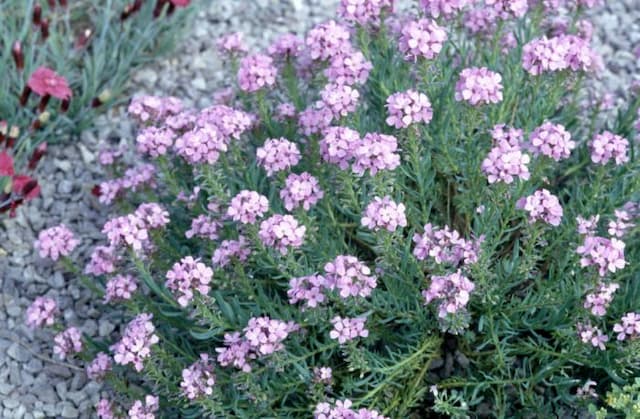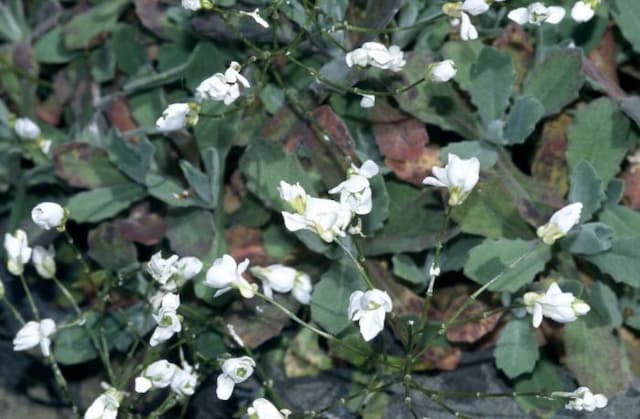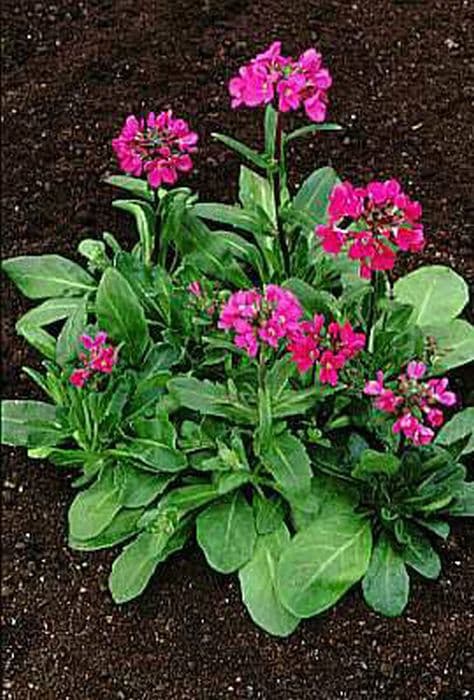Wallflower Erysimum × marshallii 'Orange Monarch'

ABOUT
The 'Orange Monarch' is a striking garden plant known for its vibrant orange flowers that bring a bright splash of color wherever they grow. This charming plant belongs to the wallflower family and is admired for its long-lasting blooms. Its flowers are characterized by their rich, warm hues of fiery orange that stand out against the green backdrop of its foliage. The blooms cluster together to form impressive displays that can add cheer to any outdoor space. The foliage of 'Orange Monarch' is typically a deep green, made up of narrow, lance-shaped leaves that create a dense and tidy mound beneath the flowers. The contrast between the dark foliage and the orange flowers creates a pleasing visual impact for gardeners and flower enthusiasts alike. The plant typically has a bushy habit, showcasing its flowers on upright stems that rise above the foliage, and it displays a profusion of blossoms throughout its blooming season. 'Orange Monarch' wallflowers are especially prized for their sweet, spicy fragrance that can waft through the air and attract pollinators like bees and butterflies. The plant's showy orange blooms not only catch the eye of passersby but also play a role in supporting local ecosystems by providing a valuable nectar source for friendly pollinators. Overall, 'Orange Monarch' presents a delightful combination of aesthetic appeal and ecological value, making it a cherished addition to any garden focused on color and wildlife attraction.
About this plant
 Names
NamesFamily
Brassicaceae.
Synonyms
Orange Monarch Wallflower, Marshall's Wallflower, Erysimum 'Orange Monarch'.
Common names
Erysimum × marshallii 'Orange Monarch'.
 Toxicity
ToxicityTo humans
Wallflower typically is not known for having significant toxicity to humans. Most members of the genus Erysimum are not reported to be toxic. However, as with many plants, it is still not advisable to ingest any part of the plant due to the potential risk of gastrointestinal discomfort or allergic reactions in some individuals. There is no well-documented case of severe poisoning from consuming wallflowers, but it is recommended to be cautious and avoid ingestion to prevent any possible negative effects.
To pets
Wallflower is not usually listed among the plants that are known to be highly toxic to pets. While the genus Erysimum is not specifically known for toxicity, there can still be risks associated with ingestion. Generally, symptoms from ingesting non-toxic plants might include mild gastrointestinal upset, such as vomiting or diarrhea. As per most ornamental plants, it is wise to keep wallflower out of reach of pets to avoid any potential discomfort or allergic reactions they might experience from chewing on or consuming parts of the plant. If a pet is observed consuming wallflower or showing signs of illness after potential ingestion, it is recommended to consult a veterinarian.
 Characteristics
CharacteristicsLife cycle
Perennials
Foliage type
Evergreen
Color of leaves
Green
Flower color
Orange
Height
2 feet (60 cm)
Spread
2 feet (60 cm)
Plant type
Shrub
Hardiness zones
7
Native area
Cultivar
Benefits
 General Benefits
General Benefits- Attracts Pollinators: Erysimum 'Orange Monarch' is known for attracting bees, butterflies, and other beneficial insects to the garden, enhancing pollination.
- Extended Blooming Season: This plant typically has a long flowering period, providing colorful displays from late winter through to mid-summer.
- Drought Tolerant: Once established, it is tolerant of drought, making it suitable for xeriscaping and low-water gardens.
- Low Maintenance: It requires minimal care once settled in the right environment, needing only occasional deadheading and watering.
- Landscape Versatility: Erysimum 'Orange Monarch' can be used in various garden designs, such as rock gardens, borders, and as a ground cover.
- Vivid Color: The bright orange flowers add a vibrant splash of color to the garden, which can be a focal point or an accent.
- Fragrance: The flowers often emit a light, sweet fragrance that can add an aromatic experience to the garden space.
- Resistant to Deer: This plant is generally not favored by deer, which can be beneficial in areas where deer browsing can damage garden plants.
 Medical Properties
Medical PropertiesThis plant is not used for medical purposes.
 Air-purifying Qualities
Air-purifying QualitiesThis plant is not specifically known for air purifying qualities.
 Other Uses
Other Uses- Ecological Indicator: 'Orange Monarch' can be used to signify the health of a specific type of habitat, such as calcareous soils where it thrives, indicating a well-maintained ecological balance.
- Educational Tool: In schools and educational programs, this plant is ideal for teaching about pollination and the life cycle of plants due to its attractive blooms that invite pollinators.
- Photographic Subjects: With their vivid orange flowers, these plants are popular subjects for photography enthusiasts, especially for macro photography.
- Artistic Inspiration: The unique color and structure of 'Orange Monarch' make it a great model for drawing, painting, and other forms of artistic expression.
- Floral Arrangements: The cut flowers of the 'Orange Monarch' can be used in floral arrangements to provide a bright pop of color.
- Dye Production: The bright petals could potentially be used to create a natural dye for fabric or crafts.
- Garden Design: Used as a 'filler' plant in garden design, 'Orange Monarch' can provide background color and contrast to complement other garden plants.
- Theme Gardens: This plant can be incorporated into thematic gardens, such as butterfly gardens or orange-themed landscapes.
- Plant Competitions: Gardeners may cultivate 'Orange Monarch' specifically for horticultural competitions, aiming to grow the most aesthetically pleasing specimen.
- Companion Planting: 'Orange Monarch' can be used in companion planting to attract beneficial insects that will help control pests in vegetable gardens.
Interesting Facts
 Feng Shui
Feng ShuiThe Wallflower is not used in Feng Shui practice.
 Zodiac Sign Compitability
Zodiac Sign CompitabilityThe Wallflower is not used in astrology practice.
 Plant Symbolism
Plant Symbolism- Resilience: As a hardy perennial, Orange Monarch represents the ability to withstand challenging conditions and bounce back.
- Energy: Its vibrant orange flowers symbolize enthusiasm and vitality, often associated with the energy of life.
- Joy: The bright color of the Orange Monarch is commonly related to happiness and spreading joy.
- Renewal: Since many perennials die back in winter and return in spring, the Orange Monarch can embody the theme of renewal and the circle of life.
- Transformation: Like its namesake, the monarch butterfly, it can signify transformation and the ability to evolve and grow.
 Water
WaterWallflower 'Orange Monarch' prefers consistently moist soil, so it should be watered deeply whenever the top inch of soil feels dry to the touch. This may mean watering once a week, but frequency can vary based on climate and soil conditions. Use approximately 1 gallon of water per plant each time you water, ensuring it's distributed evenly around the base of the plant. During particularly hot or windy periods, it may require more frequent watering to prevent the soil from drying out. Conversely, reduce watering in cooler, rainy periods to prevent root rot.
 Light
LightWallflower 'Orange Monarch' thrives in full sun where it can receive at least 6 hours of direct sunlight each day. The ideal spot for this plant is in a south-facing garden bed or against a wall that receives ample sunshine. It can tolerate partial shade but flowering may be reduced.
 Temperature
TemperatureWallflower 'Orange Monarch' performs best in temperatures ranging between 65°F and 75°F. It is cold hardy and can survive minimum temperatures down to about 20°F, but should be protected from harsh winter conditions. During the peak of summer, if temperatures consistently exceed 80°F, the plant may need additional watering to stay healthy.
 Pruning
PruningWallflower 'Orange Monarch' should be pruned to encourage bushier growth and more abundant flowering. Prune back by about one-third in late spring or early summer after the first flush of blooms has faded. Deadhead spent flowers regularly to promote continuous blooming throughout the season. The best time to perform significant pruning and shaping is in the spring.
 Cleaning
CleaningAs needed
 Soil
SoilWallflower 'Orange Monarch' thrives in a well-draining, loamy soil mix enriched with compost or well-rotted manure. The ideal soil pH for wallflowers should be slightly alkaline, ranging from 7.0 to 7.5. Ample organic matter will help retain moderate moisture while also providing essential nutrients.
 Repotting
RepottingWallflower 'Orange Monarch' does not require frequent repotting and can generally be repotted every two to three years. Due to its biennial nature, it may only need repotting if grown as a perennial or to refresh the soil.
 Humidity & Misting
Humidity & MistingWallflower 'Orange Monarch' is adaptable to a wide range of humidity levels; however, it prefers moderate humidity. It can tolerate some dry air but excessive dryness may affect its growth.
 Suitable locations
Suitable locationsIndoor
Place in bright, indirect light with some direct sun.
Outdoor
Choose a sunny spot, shelter from intense afternoon sun.
Hardiness zone
5-9 USDA
 Life cycle
Life cycleThe life cycle of Erysimum × marshallii 'Orange Monarch', commonly known as Wallflower, begins with seed germination, which typically occurs in spring or autumn under favorable moisture and temperature conditions. Seedlings then develop into juvenile plants with a rosette of leaves close to the ground. As the plant matures, it sends up one or more flowering stems, which bear clusters of orange flowers typically in the spring, but it can bloom throughout the growing season. After pollination, which is often facilitated by insects, the flowers develop into long, narrow seed pods known as siliques. Upon maturing, these seed pods split open to release seeds, completing the reproductive cycle. The plant is a short-lived perennial or biennial, and after flowering for one or more seasons, it will eventually senesce and die, although it can self-seed under the right conditions.
 Propogation
PropogationPropogation time
Spring to summer
Erysimum × marshallii 'Orange Monarch', commonly known as Wallflower, is frequently propagated through semi-ripe stem cuttings. This method is most effectively carried out in late summer. When propagating 'Orange Monarch' from cuttings, one would select healthy, semi-ripe stems and cut a 3 to 4-inch (approximately 7.5 to 10 centimeters) section just below a leaf node. The lower leaves should be stripped, and the cutting may be dipped in rooting hormone to encourage root development. The prepared cutting should then be inserted into a pot filled with a well-draining potting mix and kept moist. It's important to place the pot in a warm, bright place but out of direct sunlight to allow roots to establish. With proper care, the cutting will develop a robust root system that will eventually enable it to be planted out into the garden.






![Aubrieta [Axcent Burgundy]](/_next/image?url=https%3A%2F%2Fplants-admin.emdemapps.com%2Fimages%2Fplants%2F%2Fimages%2F604b5b7b548d8.png&w=640&q=75)


